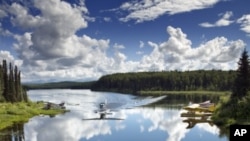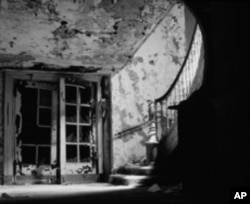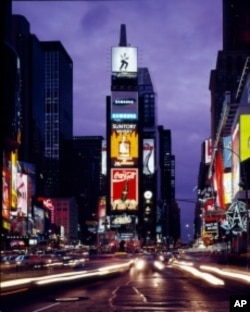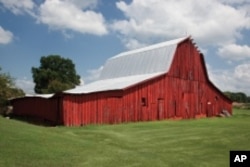Washington-based photographer Carol M. Highsmith's lens has been capturing the American landscape for 30 years. Some of those images appear regularly on the VOA website - in weekly blogs by her husband, business partner and VOA reporter, Ted Landphair.
Highsmith's latest project is a collaboration of a different sort. She's entered into a unique long-term partnership with the Library of Congress to take a 50-state tour documenting the cities, towns and countryside of 21st-century America.
Early years
Highsmith loves taking pictures; something she's done professionally for the past 30 years.
"I think the thing that I love so much is, I’ll be behind the camera concentrating on taking the photograph correctly, and then I’ll get home and look at it and think, 'Oh, how fantastic,' or 'How interesting,' and just love it and caress it and enjoy it," she said.
Highsmith recalls a wonderful childhood, spending time in the southern state of North Carolina, where she was born, and in Minneapolis, Minnesota during her teenage years.
"So I spent my summers with my granny on her tobacco farm, and then the other half of the summer with my very elite grandmother who took us to the opera," Highsmith says. "So I got a real good look-see at the south in the summer, and then in the winters skating on the ponds of the lakes of Minnesota. So I had a lot of Americana long before I left my home."
She became interested in photography partly because her father constantly took pictures and home movies of her and her older sister. That experience, she says, made her appreciate the importance of the documentary process. However, what really got her seriously interested in photography was a gift of a camera, just before she went on a trip to Russia.
"I came back and I had all these fascinating photographs of Russia," she says, "and I thought, you know, "I like this.'"
A career in pictures
Highsmith was hooked.
After returning to her home in Washington, D.C., she signed up for classes at the Corcoran School of photography. Her career as a professional photographer began in the 1980s, when she was in her thirties, documenting the restoration of historic buildings in the nation’s capital. Her first subject was the restoration of The Willard Hotel, an architectural landmark which stands just two blocks from the White House.
Highsmith was inspired in her work at the Willard by Frances Benjamin Johnston, a renowned architectural photographer who had taken pictures of the same hotel 80 years before.
"She had worked in the Willard Hotel in 1901. And at that time the Willard was women with long, white gloves and very elegant, and it was the hotel of presidents, and it was beautiful," says Highsmith. "She had taken about 30 interior photographs, and that’s how they were going to restore the Willard hotel."
The America of our time
During the past 15 years, Highsmith has traveled across America, earning awards for her photographic work for clients such as Random House, one of the world’s largest publishing companies. She has created more than 300,000 images and her book-format collections have sold more than 1.5 million copies nationwide.
But Highsmith is especially excited about her newest project. She plans to travel to every state in the U.S. over the next 10-to-15 years, documenting everything from major historic landmarks and buildings, to landscapes and images of small-town America.
"It’s probably still very important for me to continue on and photograph America at the turn of the 21st century," she says. "And do a more thorough study of it. And not have it so much driven by the project I’m working on, but driven by the state and what it has to offer."
Highsmith is collaborating on the ambitious project with the Library of Congress in Washington, D.C. The library already has about 10,000 of her earlier photographs in its collection. She plans to donate another 10,000 new images each year to the library, all of which will be in the public domain, copyright-free.
Her goal is to capture the essence of what America looks like - today.
"What is America? Maybe we should start with what isn’t it? What is it not? It’s everything. It’s a million things," she says. "It does have a look to it. If you said, 'Okay, let’s look at these set of images and these set of images and these were taken in Europe or these were taken in Africa,' you’d probably know the difference. There’s an America look."
Snapshot in history
The project allows her the luxury of spending a substantial amount of time in each state, photographing images she feels America is most at risk of losing.
"We are so diverse," she says. "We’re everything from the Grand Canyon to a wooden barn. But you know our wooden barns are disappearing. Now the Grand Canyon probably won’t, but the wooden barns are."
The images Highsmith is now capturing will help preserve whatever might be lost.
Ford Peatross is a director in the Prints and Photographs Division of the Library of Congress. He works closely with Highsmith on her latest project.
"Carol is a very fine photographer, technically, aesthetically and from a human point of view. She sees when she goes to a place, things that other people are often blind to."
According to Peatross, Highsmith’s work is already featured among the top six collections on the Library’s website alongside two iconic names in the history of modern photography: celebrated Civil War photographer Matthew Brady and photojournalist Dorothea Lange, whose haunting portraits have come to symbolize Depression-era America in the 1930s and 40s.
"These are subjects that, through their images, tell us about who we were," says Peatross. "Carol is doing photographs that tell us about who we are. Some day they will tell us about who we were."














